Ryan Hall's Blog, page 226
August 16, 2016
Training Plan: 8 Weeks to a Fall Marathon Finish Line
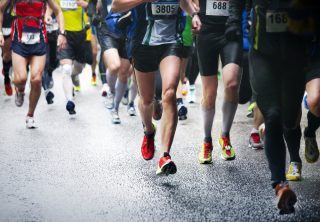
Photo: Shutterstock.com
Excerpted from “The Official Rock ‘n’ Roll Guide to Marathon and Half-Marathon Training”
It’s late-summer and suddenly some friends tell you they’re going to run a fall marathon—and you should join them. What?! Is there time to get in decent enough shape to finish it? Yes, of course, assuming you’ve been active and running a bit since the spring. We’d normally suggest a 12- to 14-week plan for optimal marathon training, but if you don’t have that much time you can still improve your situation in the next two months. Here’s an eight-week plan aimed at getting you to the finish line with more aerobic fitness than you have now. You might not set a new PR, but you’ll still savor the moment you cross the finish line.
Free 8-Week Marathon Training Plan
RELATED:
—4-Week Half-Marathon Peaking Plan
—5 Tips for Sticking with Your Training Plan
—What to Do When Your Training Plan Isn’t Working
The post Training Plan: 8 Weeks to a Fall Marathon Finish Line appeared first on Competitor.com.
Photos: Clayton Murphy Earns Bronze in 800m
On Monday night in Rio de Janeiro, rising American middle-distance star Clayton Murphy turned in a stellar performance in the men’s 800m run, earning the bronze medal is his first international championship. Kenya’s David Rudisha successfully repeated his 2012 gold medal effort by winning the race in 1:42.15 and was followed by silver medalist Taoufik Makhloufi (1:42.61) of Algeria. Murphy, a former University of Akron runner, had been a bit boxed in on the backstretch in sixth place, but, after passing fellow American Boris Berian, he closed hard over the final 150m, coming from fifth place at the top of the turn to finish third in 1:42.93.
Murphy, 21, who grew up on a pig farm in New Madison, Ohio, ran the third-fastest time in U.S. history and earned the first medal by a U.S. male since Johnny Gray took bronze in 1992. Berian, the 2016 world indoor champion in the 800m, finished eighth in 1:46:15.
RELATED: Emma Coburn Earns Bronze in 3,000m Steeplechase
Check out the photos of Murphy below from PhotoRun.net:
Photo Gallery
1 of {count}
Back to Start
View Larger Image

View Larger Image

View Larger Image


More Galleries
The post Photos: Clayton Murphy Earns Bronze in 800m appeared first on Competitor.com.
How Fitness Personality Robin Arzón Empowers Others to Run
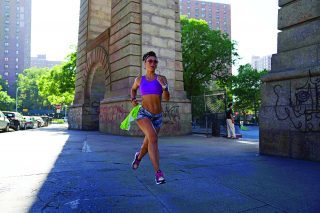
Photo: Sue Kwon
Before walking away from her job as a successful corporate litigator in Manhattan, sweating was something Robin Arzón did during the hour or so a day she could steal away for a run or a workout. Now, through creativity, hard work and hustle, the 34-year-old has made sweating a career.
Arzón is an RRCA-certified running coach and an NASM-certified personal trainer. She also leads 10 to 12 classes per week as a senior instructor at NYC-based Peloton Cycle. She uses a sliding scale of intensity to incorporate her Peloton, yoga, cycling and boot camp workouts into her training plan. And as if that weren’t enough, she recently released a new book, Shut Up and Run, to share her message of strength through sweat.
“There is nothing more powerful than pushing and pulling your body weight in the world and owning that space,” says Arzón, who believes sweat has the power to change lives, and calls herself a proselytizer of sweat. “I find that inspiring. Thankfully I hear those stories every day and it’s not lost on me that I’m privileged to be part of others’ journeys.”
Arzón, who calls New York City home, claims the marathon as her favorite running distance because she says there is always a point during training and in the race when you have to dig. She’ll run the New York City Marathon for the sixth time this November, but she’s also not afraid to take her blinged-out street style to the trails, with finishes at three 50-milers. Her favorite race, however, is the Keys 100, a 100-mile road race from Key Largo to Key West in Florida. Arzón chose it as her first 100-miler, and ran it this past May.
“I lead with curiosity, that usually takes you to the right place,” says Arzón of what guides her athletic and life choices. “I’ve always been bold, maybe a little naïve too. But I didn’t let what I didn’t know discourage me. I just keep showing up and I think that’s the point.”
But when she was growing up in Philadelphia, Arzón eschewed sports for arts and crafts. She started working out during law school and discovered running by signing up for a 10K on a whim. She was 23 years old when she ran her first mile. Now she’s inspired by the marriage of movement and meaning with running as her art form. To fuel her fire, she surrounds herself with artists and athletes, and is constantly fed by others sharing the stories of their first 5K or other accomplishments.
She traces her journey of self-discovery to her parents. Her mom, a physician, and her dad, an attorney, always told Arzón and her sister to listen to their inner voice.
“As long as we were making the next best decision to keep us safe and largely secure, they supported it,” Arzón says. “When I first left law, it became my ‘Plan B.’ Now it’s my ‘Plan F.’”
One lesson Arzón learned from her mother is that she hails from “resilient stock.” That truth has been put to the test over and over in Arzón’s life. The first was when Arzón, then a senior at New York University, was taken hostage and held at gunpoint in an East Village bar. The inveterate communicator did her best to reason with the perpetrator, while another woman eventually saw an opportunity to tackle him and end the standoff. Throwing herself into law school and fitness were the ways Arzón dealt with the trauma.
Then her mother was diagnosed with multiple sclerosis. Arzón joined in a cross-country fundraising run for the MS Society to run the equivalent of five marathons in five days, something she said she had no business doing at the time but gritted through anyway. In 2014, Arzón was diagnosed with Type 1 diabetes. She was outfitted with an insulin pump and was determined to not let the disease decide her life. It’s a real thing she has to deal with every day, but between the latest technology and eating an anti-inflammatory, vegan diet, she makes it work.
“I do really believe that most people, when faced with something daunting or harrowing, are going to be stronger than they think,” says Arzón. “There is something primal and beautiful about the instinct to survive. I’m a survivor.”
She’s also busy. Arzón admits she doesn’t take as many rest days as she would recommend for others, saying sleep—up to 10 hours a night—meditation, quiet time, journaling (old-school with pen and paper) and acupuncture help to keep her going.
“To me training, running, cycling are a lifestyle,” she says. “I see races as semicolons, and I want my life to be one long, run-on sentence filled with sweat.”
On occasion Arzón takes one rest day a week. More often than not, she’s fitting upward of four workouts into a day. The result is a continual parade of freshly styled workout looks, with three or four outfit changes a day. Luckily fashion and feeling good about how you look is important to the sweat diva, who usually showers twice a day. She says that in between workouts, spray deodorant, powder and baby wipes go a long way.
“As a lawyer, my suit game was fly,” says Arzón who has a partnership with adidas. “Now I look at Lycra as my business clothes, and being styled makes me feel proud, almost like I’m wearing a cape.”
Arzón’s sweat-filled life overflows with vibrant colors, bold patterns, jewelry (she always races in a gold jaguar ring on her right index finger) and unapologetically on point cat-eye eyeliner, even when crossing a finish line.
“I have perfected how to do a marathon in cat-eye eyeliner,” Arzón says. “Ultimately I believe sweat is my best accessory. I just add some other warrior gear on top to keep it fly.”
This is the real her through and through. Chalk it up to her Puerto Rican and Cuban heritage, and a familial love so fierce she had some of her mom’s pearls of wisdom (Resilient Stock) tattooed on her ribcage.
Even as a self-proclaimed “energizer bunny,” she has low points, admitting there are moments when she feels private and wants to be quiet.
“Sometimes I’m in a mood and that shows,” Arzon says. “I cannot lead a class or do what I do with any amount of artifice. I only know to do one thing and that’s to be myself better and better.”
There are also times when even Arzón gets scared. And she says it’s those moments of boldness that matter. Whether it’s feeling scared at leaving her law career, feeling like a “fake” when she first called herself an athlete or getting a little nervous every time she steps on a track, being epic, to Arzón, is being fearful and doing it anyway. And she sets herself up to have those moments regularly.
The post How Fitness Personality Robin Arzón Empowers Others to Run appeared first on Competitor.com.
August 15, 2016
Photos: Emma Coburn First U.S. Woman to Medal in Steeplechase
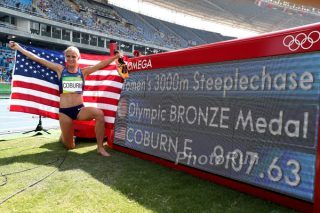
2016 Olympic Games
Rio De Janeiro, Brazil August 12-21, 2016
Photo: Victah Sailer@PhotoRun
Victah1111@aol.com
631-291-3409
www.photorun.NET
Early on Monday morning, American Emma Coburn ran an impressive race in the 3,000m steeplechase at the Rio Olympics, claiming the bronze medal. Not only did the 25-year-old Colorado native earn a medal, but she also lowered her own American record to 9 minutes and 7.63 seconds and became the first American woman ever to medal in the steeplechase since it was added to the women’s Olympic program in 2008.
Although Bahrain’s Ruth Jebet dominated the race, winning gold in 8:59.75, it was a battle for second between Coburn and Kenya’s Hyvin Jepkemoi in the final lap when Coburn made her move to surge ahead into third place. Jepkemoi finished a half-second before Coburn to take silver.
“I’m a little bummed I didn’t have a little more in the last lap to get second, but third in the world is really incredible,” Coburn told NBC after the race. “I’m really happy.”
Coburn, who grew up in Crested Butte, Colo., lives and trains in Boulder, where she was an All-American and NCAA champion for the University of Colorado.
VIDEO: Emma Coburn Explains the Steeplechase
Here’s a photo recap of Coburn’s record-breaking race. Highlights from the race can be viewed on NBC’s Rio Olympics website.
Photos: Photorun.net
Photo Gallery
1 of {count}
Back to Start
View Larger Image
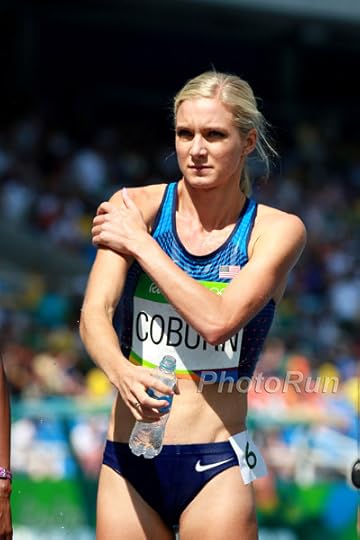
View Larger Image

View Larger Image

View Larger Image
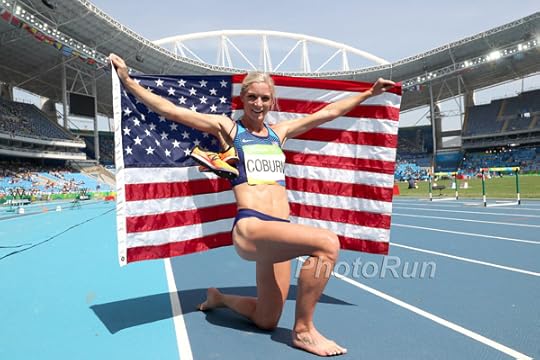
2016 Olympic Games
View Larger Image
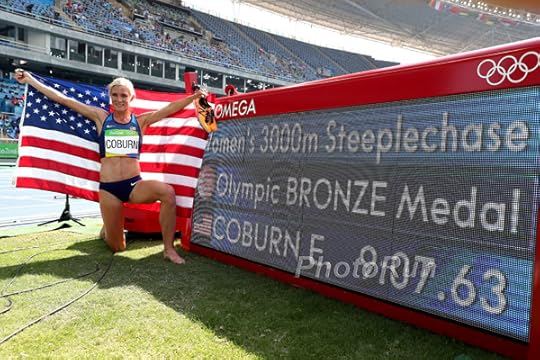
View Larger Image
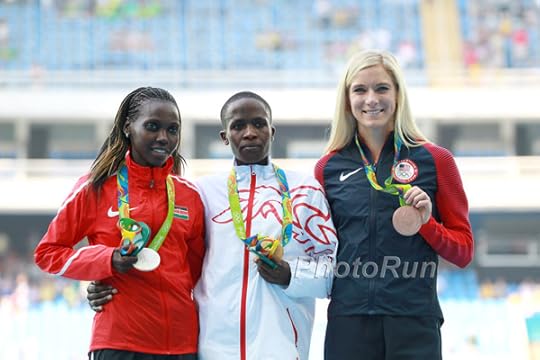
View Larger Image
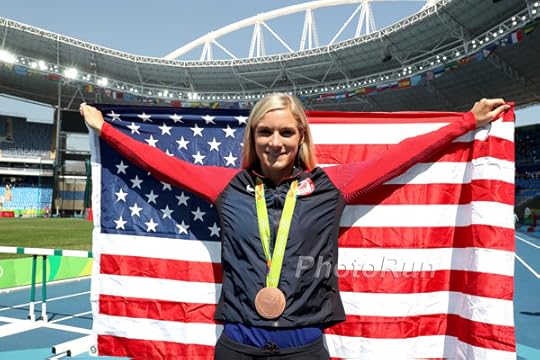
View Larger Image

2016 Olympic Games
Related Galleries
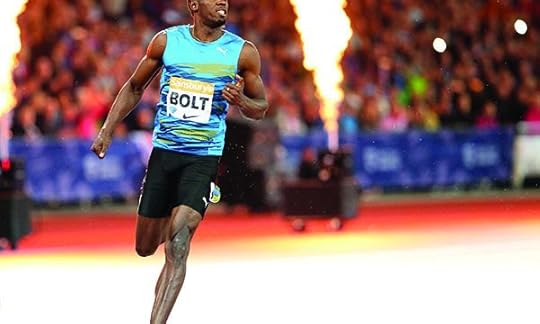
Top International Runners to Watch at the Rio Olympics
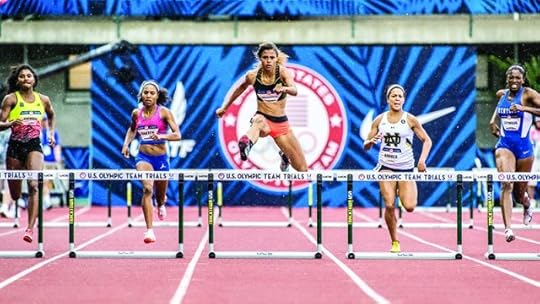
America’s Top Track & Field Olympic Medal Contenders
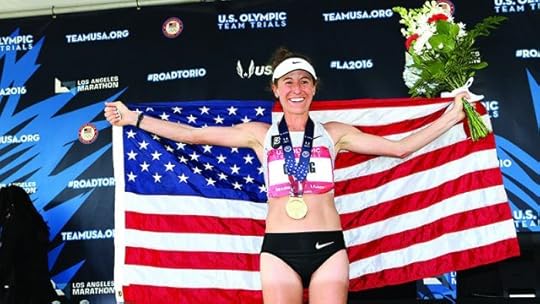
American Women to Watch in the Olympic Marathon

Photo Gallery: Generation Next In The U.S.

More Galleries
The post Photos: Emma Coburn First U.S. Woman to Medal in Steeplechase appeared first on Competitor.com.
August 12, 2016
Shoe of the Week: ASICS DynaFlyte
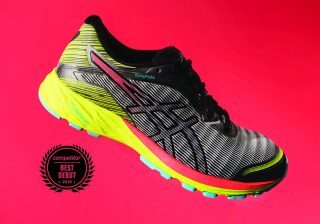
FIT/FEEL/RIDE: ASICS developed this new highly responsive neutral training shoe built on its innovative and very lightweight FlyteFoam midsole material—made from proprietary foam and organic fibers that help limit the amount of deformation in each footstrike. It serves up a superlative ride, which is a mix of cushy, stable and responsiveness. The shoe feels low to the ground, but not in a vulnerable way that many minimalist shoes can feel. It’s a true cushioned high-mileage trainer with a speedy demeanor that’s more akin to a racing flat. That’s partially due to the foam midsole being 55 percent lighter than similar EVA foam midsoles, as well as easy-flexing characteristics from strategically placed forefoot flex grooves. It has a section of high-abrasion carbon rubber in the heel for long-lasting durability. A few of our wear-testers felt that the guidance provided by the DynaFlyte, while adequate for neutral runners, may not be enough for moderate overpronators. But we liked this shoe enough to give it our Best Debut award in our Fall 2016 Road Running Shoe Buyer’s Guide in our August issue.
This is the shoe for you if … You’re looking for a versatile, lightweight and softly cushioned trainer capable of doing all kinds of runs you do during a week.
Price: $140
Weights: 9.5 oz. (men’s), 7.8 oz. (women’s)
Heel-to-Toe Offset: 8mm; 25mm (heel), 17mm (forefoot)
Info: Asics.com
RELATED: Shoe of the Week—Hoka One One Clifton 3
The post Shoe of the Week: ASICS DynaFlyte appeared first on Competitor.com.
Huddle Breaks 10,000m American Record, Finishes 6th in Rio
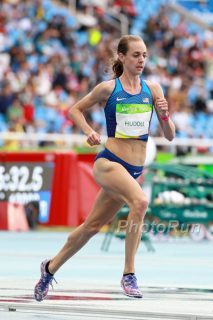
Molly Huddle ran to a new American record while finishing sixth in the fastest 10,000m race in history. Photo: PhotoRun.net
A very quick early pace in the women’s Olympic 10,000m run on Friday morning in Rio de Janeiro had Molly Huddle tucked in at the back of an eight-woman lead pack through 2K, passing in just under 6:00. The rapid pace continued through 3K, with Huddle still in eighth as the leaders went past in 8:52.79. By the 4K mark Huddle had fallen off the top seven by about 10m as the leaders were on near-world record pace. Huddle made up ground through 5K, passing Ethiopia’s Gelete Burka and moving into seventh while pacing herself at nearly 15 seconds under American record pace for the 10,000m and just four seconds off her 5,000m American record.
Huddle, 31, a Saucony-sponsored athlete from Elmira, N.Y., continued to look strong over the second half of the race, lapping many of her competitors but staying focused on the task at hand. She was well under American record pace over the final laps, utilizing Kenya’s Betsy Saina as a pacemaker. Huddle crushed the American record as she finished sixth in 30:13.17 in the greatest women’s 10K ever run.
Ethiopia’s Almaz Ayana shattered the world record in 29:17.45, while the silver medalist Vivian Cheruiyot was nearly under the previous world record (29:31.78) as well with her runner-up finish in 29:32.53. Huddle’s mark broke the previous American record held by Shalane Flanagan, who ran 30:22.22 while earning the bronze medal in the 2008 Olympic in Beijing.
Running a lifetime best 31:26.94, 2015 IAAF World Championships bronze medalist Emily Infeld (University Heights, Ohio) came in 11th. Marielle Hall (Haddonfield, New Jersey) finished 32nd in 32:39.32.
The post Huddle Breaks 10,000m American Record, Finishes 6th in Rio appeared first on Competitor.com.
Video: American Sprinter Tori Bowie Says Track Saved Her Life
American sprinter and long jumper Tori Bowie went through a lot growing up in Sandhill, Miss. But she says track helped her “stay in my own lane” and keep her on the straight and narrow. Bowie earned at bronze medal in the 100-meter dash at the 2015 world championships and will be going for more hardware in Rio after winning the 200m and placing third in the 100m at the U.S. Olympic Trials in July.
The post Video: American Sprinter Tori Bowie Says Track Saved Her Life appeared first on Competitor.com.
The Science Behind the Olympians
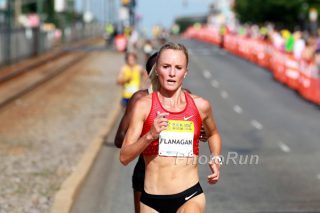
Shalane Flanagan is a four-time U.S. Olympian, but certainly her success is derived from more than just her athletic genes. Photo: PhotoRun.net
Once every four years, people from all nations watch the Olympic Games and marvel at the greatest athletes in the world. What is it that allows them to run, jump, and throw two to three times faster and farther than the average person? Is it good genes or sheer hard training?
Scientists have been looking into these questions for almost as long as the Olympians have been setting new records. Along the way, we have uncovered many answers, while much remains to be explained.
Some athletes, like USA cyclist Taylor Phinney, seem to have followed the suggestion of the Swedish physiologist Per Olaf Astrand, who once joked, “If you want to be an Olympic champion, then choose your parents wisely.” Phinney’s parents are cycling royalty. His mom, Connie Carpenter-Phinney, won a gold medal in the 1984 Summer Olympics in the women’s road race. His dad, Davis Phinney, was a bronze medalist in the 1984 Olympics and a stage winner in the Tour de France.
Among U.S. distance runners, Shalane Flanagan has a similarly unmatched pedigree. Her mother was the first female marathoner to break 2:50, her father a 2:18 marathoner and several times a member of the U.S. team that competed in the World Cross Country Championships.
However, it is not just genes that make a great athlete. Getting an early start in sports also seems to benefit future Olympians. A study conducted at the 1976 Summer Games in Montreal found that most of the Olympians surveyed had at least one older sibling. The scientists speculated that trying to keep up with an older brother or sister helped them develop essential motor skills for sport.
RELATED: How to Watch Track & Field at the Rio Olympics on TV
Runners’ hearts are one of many factors that determine their success. Not only do Olympic athletes have enlarged hearts, but echo cardiograph and MRI studies have shown that endurance athletes have hearts with larger chambers that allow them to pump more blood. In Peter Snell’s case, this lead to a finding that baffled scientists at first.
Snell, from New Zealand, was once the world’s most dominant middle-distance runner despite being built more like a muscular sprinter than a lean miler. He won gold in the 800 meters in 1960, and gold in both the 800 and 1500 meters in 1964. Exercise physiologists at San Diego State University found that, oddly enough, Snell’s lungs failed to saturate his blood with oxygen during maximal exercise. Normally this is a sign of pulmonary disease, which seemed unlikely in Snell’s case. Eventually the scientists determined that his large athletic heart propelled blood through his lungs so quickly that there wasn’t enough time to saturate the red blood cells with oxygen. Even so, Snell’s aerobic power was great enough to beat back his rivals.
In 1975, 20 top distance runners were evaluated at the Institute for Aerobics Research in Dallas. Treadmill tests revealed that their maximal oxygen uptakes were nearly twice as high as that of the average man. They also had low levels of body fat and high proportions of slow-twitch fibers. Steve Prefontaine had the highest maximal oxygen uptake of all the runners (84 milliliters of oxygen per kilogram per minute), while Frank Shorter had the lowest (71 milliliters).
Prefontaine’s high max and relatively high percentage of fast-twitch muscle fibers allowed him to unleash a 54-second last lap at the end of 5,000-meter races. This brought him 15 American records at distances from two miles to 10,000 meters, and a fourth place in the 1972 Olympic 5,000.
Despite his lower max, Shorter excelled at another important measure: running economy. He was more efficient than the other runners tested, meaning that he consumed less oxygen while running at a given speed. In addition, he could maintain a high percentage of his max for extended periods of time. These traits allowed him to cruise to a seemingly effortless win in the 1972 Munich Olympic Marathon.
Sprinters have a different kind of muscle fiber. Colin Jackson, a Welsh sprinter and hurdler who was a silver medalist in the 1988 Seoul Olympics, set a world record of 12.91 seconds in the 110-meter high hurdles in 1993. In 2013, a BBC film crew followed him to the Ball State University Human Performance Laboratory in Muncie, Indiana. There scientists removed small samples of his thigh muscles so they could study them in the laboratory. The results showed, as expected, that nearly three-quarters of Jackson’s muscle fibers were of the fast-twitch variety. However—and this was the surprising part—one third of his fast-twitch muscle fibers were super-fast, which are very rare. His super-fast fibers were six time as powerful as his regular fast-twitch fibers and 12 times as powerful as his slow-twitch fibers. No doubt about it: Jackson was born to sprint.
The external environment is as important as the body’s internal characteristics. When Jim Ryun began preparing for the 1968 Olympic Games in Mexico City, he had little respect for the altitude. “At that time most people, myself included, thought it was mostly a psychological problem,” he said. Then he ran his first time-trial at altitude. Result: a 4:29 mile—38 seconds slower than his best sea-level mile. That served as a wakeup call that he needed to do some serious altitude training before the Games. He did, and ran well in Mexico City (earning the silver medal), but had little chance against Kenya’s Kip Keino, born and raised at high altitude in the Rift Valley region of his country.
The 1984 Olympics, held in Los Angeles, posed a hot-weather challenge for athletes. U.S. marathon star Alberto Salazar was advised by a team of heat and hydration scientists, including U.S. Army experts. They found that he sweated in excess of 2.75 liters per hour, and advised him to train in hot conditions (he spent some time in Houston) and to practice drinking large amounts of water on the run. Salazar ran strongly under a hot sun in Los Angeles, but his 2:14:19 was only good for 15th place.
Getting ready for the historically important first Olympic Marathon for women, Joan Benoit trained at home in coastal Maine, with its own summer humidity. In Los Angeles, she pulled away from the pack early en route to an impressive win. Gabriela Anderson Schiess, from dry Sun Valley, Idaho, was not so fortunate. She succumbed to heat exhaustion and staggered around the final lap on the track, horrifying the L.A. Coliseum crowd and worldwide TV audience with her loss of body control. Fortunately, she recovered quickly. The episode sparked new interest in medical guidelines for hot weather marathon and in treatment of heat illnesses.
Olympic athletes seem to be not just spectacularly talented, but also healthier. In 2012, the British Medical Journal published the first large-scale study on the longevity of Olympic athletes. The authors examined more than 15,000 Olympians from nine country groups who won medals between 1896 and 2010. They concluded that Olympic medalists live about three years longer than men and women in the general population, with medalists from endurance sports having a greater survival advantage than those from the power sports. Of course, no one can be sure if the Olympians’ longevity is due toexercise, good genes, or overall healthier lifestyles; it’s probably a combination of all three.
Beyond teaching us about physiology, Olympic athletes impress us with their examples of the boundless human spirit. At the 1964 Olympics, Billy Mills improved his personal best by 50 seconds to win the 10,000. Bob Beamon produced the “leap of the century” in Mexico City, improving the world long-jump record by almost two feet, an effort that defies all attempts at scientific analysis. And how do you explain gymnast Kerri Strug completing her final vault at the 1996 Olympics on a badly injured ankle?
These and all Olympic performances remind us of the words of Baron Pierre de Coubertin, founder of the modern Olympic Games: “The important thing in life is not the triumph but the struggle; the essential thing is not to have conquered but to have fought well.”
RELATED: Complete 2016 Olympics Track & Field Schedule
****
About The Authors:
David Bassett is professor and head of the Department of Kinesiology, Recreation, and Sport Studies at the University of Tennessee, Knoxville. Scott Conger is an assistant professor in the Department of Kinesiology at Boise State University. They have developed a course called Physiology of Athletes: Exploring the Limits of Human Performance.
The post The Science Behind the Olympians appeared first on Competitor.com.
August 11, 2016
Top International Runners to Watch at the Rio Olympics
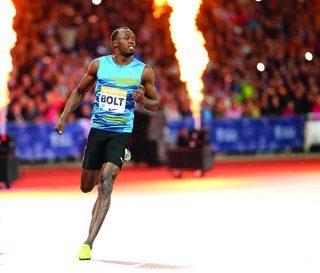
We may be rooting for Team USA, but these international stars will be interesting to watch too. Here’s a glimpse at some compelling international athletes competing in the Olympics this year.
RELATED: America’s Top Track & Field Medal Contenders
PHOTOS: A glimpse inside Usain Bolt’s Tracks & Records sports bar in Kingston
Photo Gallery
1 of {count}
Back to Start
View Larger Image

Usain Bolt, Jamaica
Is this guy still the fastest man on the planet? Bolt, who turns 30 the day the Olympics conclude, tweaked a hamstring in July and missed the Jamaican track and field trials, but he was put on the team anyway. In Rio, the Jamaican sprinter could win an unprecedented third straight 100m/200m Olympic sprint double. And if he also wins the 4x100m relay, as he did in Beijing and London, Bolt’s Olympic gold medal tally would stand at nine. Finnish distance runner Paavo Nurmi (9 gold, 3 silver) and American sprinter/jumper Carl Lewis
(9 gold, 1 silver) are the only track and field athletes with more medals. Photo: Photorun.net

Shelly-Ann Fraser Pryce, Jamaica
Nicknamed the “Pocket Rocket” (she stands just 5 feet tall), this 29-year-old two-time Olympic gold medalist and four-time world champion in the 100-meter dash will try to retain her dominance despite a host of U.S. challengers.
View Larger Image

David Rudisha, Kenya
This Maasai Warrior turned in the single most astonishing performance of the 2012 Olympics with an 1:40.91 world record in the 800m. He hasn’t been at the same level since, but the 27-year-old is still one of the best in the world (1:44.23 so far this year) and won the 2015 world championships. Photorun.net
View Larger Image

Almaz Ayana, Kenya
This 24-year-old burst on the scene last year with a world championships win in the 5,000m. So far this year, she’s atop the leaderboard in both the 5,000m (14:12:59 or 4:34 per mile) and the 10,000m (30:07:00 or 4:50 pace). Photo: Photorun.net
View Larger Image

Asbel Kiprop, Kenya
The world’s best miler and 1,500-meter runner since 2008, Kiprop, 27, rarely loses. Aside from his disappointing 12th-place finish in the London Olympics (due to a torn hamstring), he’s won three straight world titles and owns a world-leading 3:29.33 this year (through July 15). Photo: Photorun.net
View Larger Image

Genzebe Dibaba, Ethiopia
Although her coach, Jama Aden, was infamously busted in a doping raid in June, the 25-year-old Dibaba has maintained her innocence. She’s dominated the middle-distance events the past few years, including an eye-popping 3:50.07 world record in the 1,500m last year—roughly a 4:07 mile! Photo: Photorun.net
View Larger Image
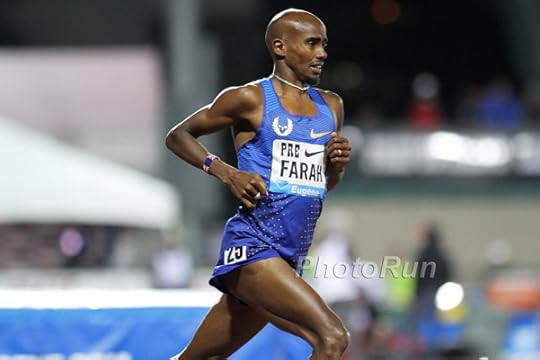
Mo Farah, Great Britain
Does mighty Mo still have the stuff that made him a double gold medalist in the 5,000m and 10,000m at the 2012 Olympics and the last two world championships? The 33-year-old Somali-born Brit ran 26:53.71 in the 10,000m to win the Prefontaine Classic in May and added a 12:59.29 5,000m in London on July 23, so it’s not like he’s washed up. He still seems to be the cream of the crop, but he'll best tested by some young, hungry runners. Photo: Photorun.net
View Larger Image
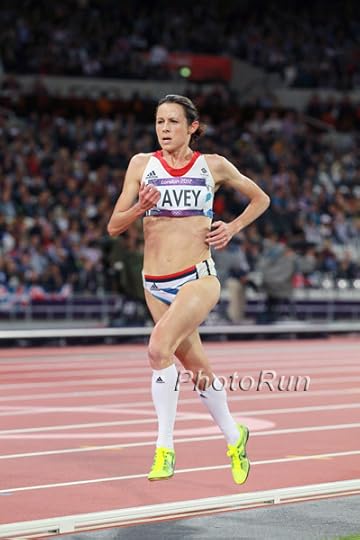
Jo Pavey, Great Britain
At 42 years, 326 days old, she’ll be one of the oldest runners ever to compete in the modern Olympics. Sure, the five-time Olympian and mother of two has lost a step, but she can still run 5-minute mile pace for 6.2 miles and could contend for a top-10 finish in the 10,000m. Photo: Photorun.net
Related Galleries

America’s Top Track & Field Olympic Medal Contenders

American Women to Watch in the Olympic Marathon

More Galleries
The post Top International Runners to Watch at the Rio Olympics appeared first on Competitor.com.
America’s Top Track & Field Olympic Medal Contenders
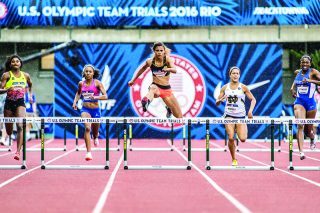
Here’s a look at some of the top U.S. track and field competitors heading into the Rio Olympics. Track and field competition begins on Aug. 12 and concludes on Aug. 21 with the men’s marathon.
RELATED: How to Watch Track & Field in the Rio Olympics on TV
RELATED: Americans to Watch in the 2016 Olympic Marathon
RELATED: Complete 2016 Olympics Track & Field Schedule
Photo Gallery
1 of {count}
Back to Start
View Larger Image

Ashton Eaton, Decathlon
What can we say about the world’s greatest athlete that hasn’t already been said? This dude is absolutely amazing—like a cartoon superhero! He heads to Rio as the reigning Olympic champion, current world-record holder and multiple world champion. Eaton could become only the third person in history to repeat as the Olympic decathlon champion, and the first American since Bob Mathias did it in 1948-1952. The more compelling story around Eaton might be whether he and his wife—Canadian heptathlete Brianne Theisen-Eaton—will both bring home gold medals in the multi-discipline events. Photo: Dave Albo
View Larger Image

Jenny Simpson, 1,500m
No American runner in this era has been more clutch in big races than Simpson. She’s a three-time Olympian and owns two world championship medals. She placed ninth in the 3,000m steeplechase in the 2008 Olympics, but one of her few hiccups was in 2012, when she didn’t make the finals in the 1,500m. If she continues the form she had at the U.S. Olympic Trials in July, she should wind up on the podium and could challenge for gold. Fellow Americans Brenda Martinez and Shannow Rowbury also have the talent and experience to make it to the Olympic podium, but Simpson was running at another level at the Trials. Photo: Dave Albo
View Larger Image

Galen Rupp, 10,000m & marathon
Will he stick with his plan of tackling the grueling 10,000m/marathon double? Rupp has looked both crazy fit this year and sometimes vulnerable too. Most think the grind of marathon training and his age (30) have resulted in him losing a step or two on the track, but we have no idea how good he can be in the marathon. If he’s within reach in the final mile of either race, you can’t count him out. Photo: Photorun.net
View Larger Image

Allyson Felix, 400m
Felix, 30, hoped to go for an unprecedented 200m/400m double, except she was battling a minor injury and placed fourth in the 200 at the U.S. Olympic Trials (by a mere .01 second!) and didn’t make the team in that event. Not that she needed extra motivation, but it will make her tough to beat in the 400 and she should help the U.S. contend for gold in the 4 x 400m relay too. With six Olympic medals (including four gold) already to her credit, she'll go down as one of the all-time greats no matter what happens in Rio. Photo: Photorun.net
View Larger Image

Evan Jager, 3,000m steeplechase
He’s proven he can run with the best in the world in one of the hardest events on the track. (He runs 4:18 mile pace for 1.86 miles over barriers and water jumps!) He also knows how to rock a solid man-bun too! He set a new U.S. record in 2015 and could be the first American to medal in this event since 1984. Photo: Jeff Cohen
View Larger Image

Emma Coburn, 3,000m steeplechase
Coburn has continued to up her game in recent years—fifth at the world championships last year, a new American record (9:10.76) this year—and should certainly be in the mix for medals in Rio. She made waves with her appearance in ESPN The Magazine’s Body Issue in July, but she’s bound to become a breakout star if she comes home with something shiny as the first American to medal in the this relatively new event. Photo: Matt Trappe
View Larger Image

Sydney McLaughlin, 400m hurdles
Yes, she just finished her junior year in high school, but this 17-year-old from New Jersey is world class. She’s the youngest American track athlete in the Olympics since Cindy Gilbert competed in 1972. In all fairness, American Dalilah Muhammad has a better shot at the gold, but it’s reasonable to think that McLaughlin could come home with hardware too. Photo: Matt Trappe
View Larger Image

Molly Huddle, 10,000m
Molly Huddle showed her dominance among her American peers at the U.S. Olympic Trials last month in Eugene, Ore., winning both the 5,000m and 10,000m in convincing fashion. She'll only run the 10,000m in Rio, facing many of the same runners that were in the field at last year's IAAF World Championships in Beijing. That's where she placed a heartbreaking fourth after teammate Emily Infeld snuck by her in the final meters to earn the bronze medal. That's ancient history, but Huddle is still motivated to finish on the podium—and still very capable of doing so—without looking back. However, she'll all start her preparation for the Nov. 6 New York City Marathon the week after the 10,000m final in Rio. Photo: Bob Betancourt
View Larger Image

Matthew Centrowitz, 1,500m
By winning the U.S. Olympic Trials in record-setting fashion he reached his goal of making his second Olympic team to match his dad’s legacy. But what he really wants is to erase the haunting memory of his fourth-place finish in the London Olympics (by just .04 seconds!) four years ago. He seems to be peaking at the right time, so we have to believe he’ll finish in the top three. Photo: Jeff Cohen
View Larger Image
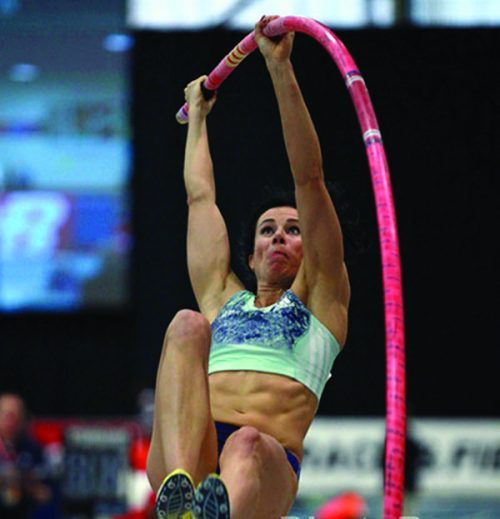
Jenn Suhr, Pole Vault
She might not be faster than a speeding bullet or be able to leap tall buildings in a single bound, but she could have fooled us! The best American pole vaulter in history (with an Olympic gold in 2012 and numerous records and other international medals), she’s still on top of her game at age 34, having won the indoor world championships in March and the U.S. Olympic Trials in July. Her career-best vault is 16-feet, 6 inches—a height that could easily put her through a second-floor window. Photo: Photorun.net
View Larger Image

Boris Berian/Clayton Murphy, 800m
It’s hard not to like Berian, the guy who was working at McDonald’s two years ago and then this year won a world indoor title and successfully fought off Nike for the right to sign a contract with New Balance. We think he’s a medal contender for sure, but what does that say about Murphy, who could be the best middle-distance runner in America this summer? As crazy as it seems, it’s possible they could both wind up on the podium. Photo: Liz Copan
View Larger Image
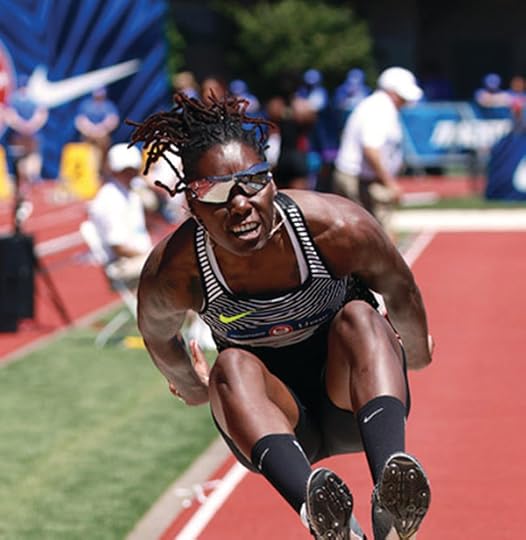
Brittney Reese, Long Jump
The best long jumper in the world since 2009, you’d think this woman must have invisible wings! The 2012 Olympic gold medalist and three-time world champion is still in top form heading to Rio after uncorking the world’s longest jump since 2004 (23 feet, 11 3/4 inches) to win the U.S. Olympic Trials in July. Photo: Photorun.net
View Larger Image
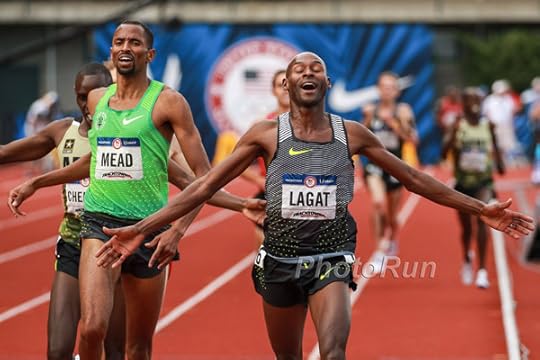
Bernard Lagat, 5,000m
It's hard to believe that Bernard Lagat can run so fast at the advanced age of 41. Not only did he win the U.S. Olympic Trials in 13:35.50 with a 52.8-second last lap on July 9 in Eugene, Ore., he rebounded from that effort to place third in an even faster race in London two weeks later, setting a new master's world record of 13:14.96. He seems to be in prime form and has plenty of experience, so it's hard to count him out in his fifth and likely final Olympics. Photo: Photorun.net
View Larger Image

Amy Cragg, Desi Linden, Shalane Flanagan, Marathon
Given how well they ran at the U.S. Olympic Trials, Desi Linden and Amy Cragg seem to the be capable of competing well at the Olympic marathon. But Shalane Flanagan has the best PR among the U.S. women, the most Olympic experience and perhaps the best closing speed. While the podium is within the reach of each of them, we could envision top 10 finishes for all three. Photo: PhotoRun.net
Related Galleries

Top International Runners to Watch at the Rio Olympics

American Women to Watch in the Olympic Marathon

Sneak Peek: Maggie Vessey’s Newest Race Kits for Olympic Trials
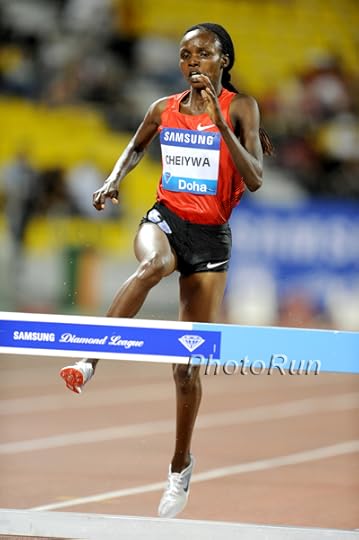
Photo Gallery: Doha Diamond League Distance Action

More Galleries
The post America’s Top Track & Field Olympic Medal Contenders appeared first on Competitor.com.
Ryan Hall's Blog
- Ryan Hall's profile
- 21 followers



